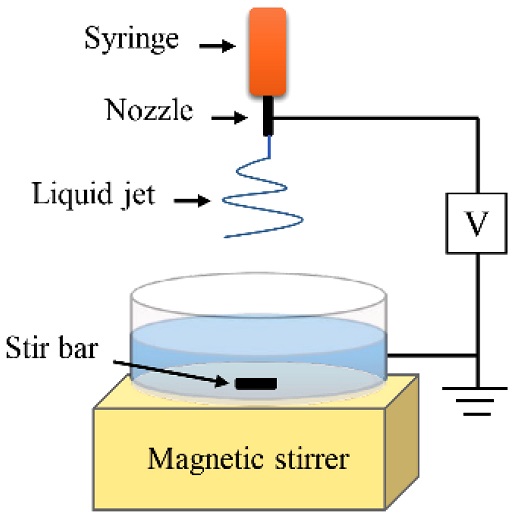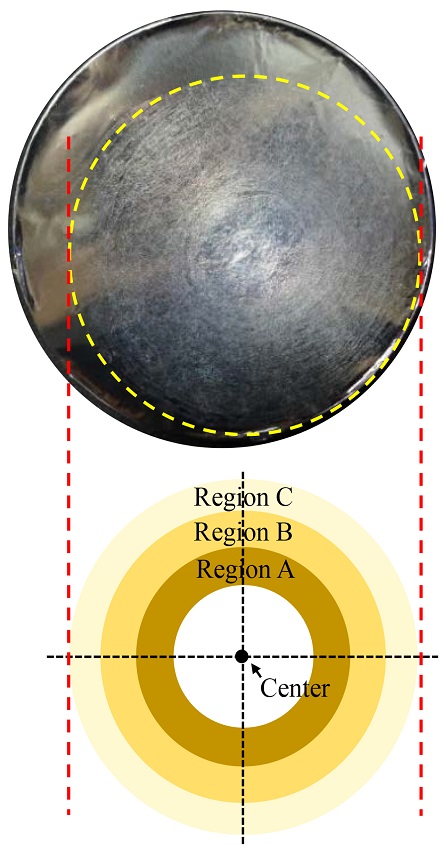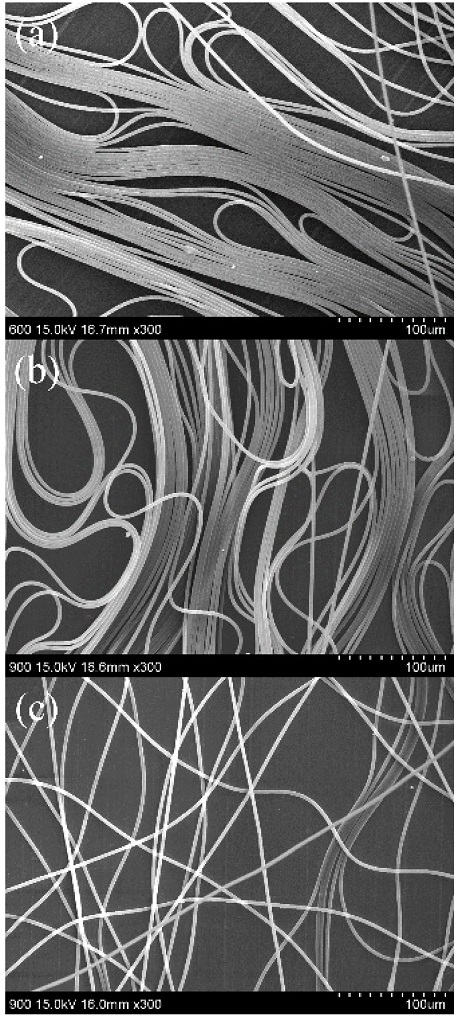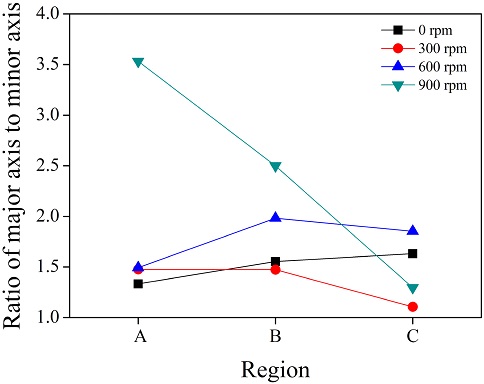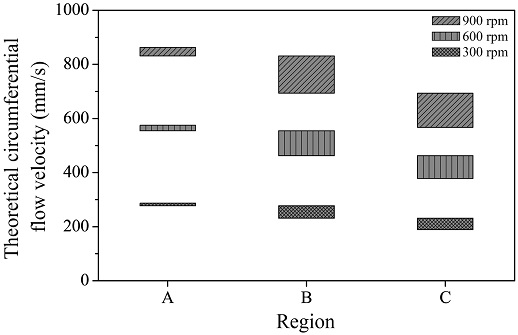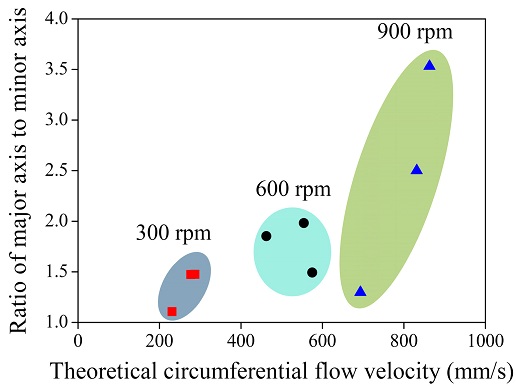
Characterization of degree of alignment of polymer microfibers electrospun on a rotating water collector
This is an Open Access article distributed under the terms of the Creative Commons Attribution Non-Commercial License(https://creativecommons.org/licenses/by-nc/3.0/) which permits unrestricted non-commercial use, distribution, and reproduction in any medium, provided the original work is properly cited.
Abstract
In this study, the degree of alignment of polymer microfibers produced by electrospinning using a rotating water collector was evaluated. Aligned micro- and nano-fibers are required in various practical applications involving anisotropic properties. The degree of fiber alignment has many significant effects; hence, and accurate quantitative analysis of fiber alignment is necessary. Therefore, this study developed a simple and efficient method based on two-dimensional fast Fourier transform, followed by ellipse fitting. As a demonstrative example, the polymer microfibers were electrospun on the rotating water collector as the alignment of microfibers can be easily controlled. The analysis shows that the flow velocity of the liquid collector significantly affects the electrospun microfiber alignment, that is, the higher the flow velocity of the liquid collector, the greater is the degree of microfiber alignment. This method can be used for analyzing the fiber alignment in various fields such as smart sensors, fibers, composites, and textile engineering.
Keywords:
Electrospinning, Microfiber, Alignment, Polystyrene1. INTRODUCTION
Electrospinning is one of the most common manufacturing technologies for fabricating micro- and nanofibers. In recent decades, electrospinning has been extensively developed and widely used owing to its simplicity and cost-effectiveness [1-4]. Nonwoven fiber mats with a densely packed but randomly oriented structure are usually produced by electrospinning. However, it is difficult to fulfill diverse demands with this primitive structure owing to the increasing applications of electrospun fibers [5]. Therefore, numerous variations of traditional electrospinning have been developed to efficiently produce fibers of diverse structures. One of these forms is the highly aligned electrospun fibers. Products with enhanced performance can be obtained owing to the unique anisotropic properties of the aligned structure. For example, enhanced mechanical properties and directional guidance of cell growth and tissue regeneration can be obtained [6-8]. Therefore, it is necessary to precisely estimate the degree of fiber alignment.
Fast Fourier transform (FFT) can be used to evaluate the degree of alignment of many fibers [9,10], where the degree of alignment is represented by the peak and contour of the FFT plot. However, owing to the lack of quantitative results, it is difficult to determine the degree of alignment when it varies by a small range. Therefore, it is necessary to develop a new method that can provide reliable results. Hence, this study developed a simple and efficient method to quantify the alignment of electrospun microfibers based on the FFT plot.
2. EXPERIMENTAL
2.1 Materials
Polystyrene (PS) (STYRON 6500, Hong Kong), tetrahydrofuran (THF, 99%, Daejung, Siheung, Korea), and N, N-dimethylformamide (DMF, 99.5%, Daejung, Korea) were used as received. A PS solution was prepared with a concentration of 20 wt% using a 1:3 weight ratio of THF and DMF as solvents. In all experiments, deionized (DI) water was used as a liquid collector.
2.2 Electrospinning of microfiber mat
Fig. 1 depicts a schematic of the experimental setup used in this study. Unlike conventional electrospinning that uses a solid collector, a liquid collector was used. A magnetic stir bar created a rotating flow in the liquid collector (DI water of 45 mm height in a circular bath of 150 mm diameter). During electrospinning, a high voltage of 18 kV was applied to the nozzle tip, where the PS solution was extruded at a constant flow rate of 0.5 mL/h. The distance between the nozzle tip and liquid surface was 28 cm. By this, the electrospun microfiber was collected on the liquid surface. To investigate the degree of fiber alignment, microfibers with different morphologies were obtained by applying four rotational speeds of the stir bar (0, 300, 600, and 900 rpm). All experiments were performed at room temperature for 30 s with 30 ± 5% RH humidity. After electrospinning, an aluminum foil was used to pick the microfibers floating on the water surface.
2.3 Characterization
The morphology of fabricated microfibers was observed using scanning electron microscopy (SEM, SU-70, HITACHI, Japan). To determine the distribution of microfiber directions, ImageJ was employed to perform a two-dimensional FFT. After representing the obtained directional distribution in a polar coordinate system, ellipse fitting was carried out. The ratio of major and minor axes in the obtained ellipse was evaluated as a measure of the degree of alignment.
In this study, three concentric regions in the fabricated microfiber mat were defined to analyze the degree of fiber alignment, as shown in Fig. 2. Beginning with 10 mm from the center of the microfiber mat, each region was set at 5 mm intervals. The centermost area was excluded from the analysis because the electrospun fibers in the center were drawn to the vortex during electrospinning, accumulating more fibers in the center region (Fig. 2). The outer regions were stable because the circumferential flow velocity was almost proportional to the applied rotational speed of the liquid collector. By this, the effect of rotational speed on the degree of fiber alignment was investigated.
3. RESULTS AND DISCUSSION
3.1 Morphological characteristics of microfibers
Fig. 3 shows SEM images of the electrospun microfibers obtained at various rotational speeds of the liquid collector in Region A. The rotational speed of the liquid collector, which can be directly correlated with the circumferential flow velocity, significantly affected the morphology. When the rotational speed of the liquid collector was 0 rpm, which corresponds to a stationary state, the microfibers were almost randomly distributed. This random distribution was similar to that of the typical electrospinning. When the rotational speed was increased to 600 rpm, the microfibers began to arrange in a particular direction. At a higher rotational speed of 900 rpm, more aligned microfibers were formed, as shown in Fig. 3(d).
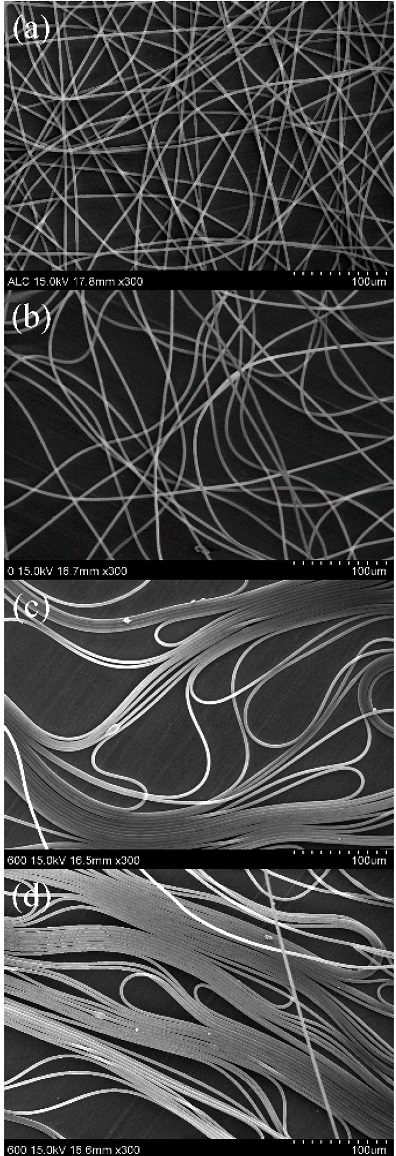
SEM images of the electrospun microfibers in Region A at various rotational speeds of the liquid collector: (a) 0, (b) 300, (c) 600, and (d) 900 rpm.
Fig. 4 shows the SEM images of the electrospun microfibers collected at the rotational speed of 900 rpm. The microfiber morphology could be varied depending on the radial position with the same rotational speed. From Region A to Region C, the degree of fiber alignment decreased. This can be attributed to the nature of the rotating flow of the liquid collector. Since the microfibers deposited on the liquid collector surface followed the fluid flow underneath them, the circumferential flow of the liquid collector facilitated the alignment of floating microfibers in that direction. The greater the rotational speed of the collector, the more pronounced the induced fiber orientation was.
3.2 Degree of fiber alignment
An example of the present analysis of the degree of fiber alignment is demonstrated in Fig. 5. The first step is to obtain the SEM image [Fig. 5(a)]. From the SEM image, the FFT plot showing the distribution of fiber orientation is generated in the second step of the FFT analysis [Fig. 5(b)]. In this example, the normalized intensity has two major peaks at approximately 30 and 210 degrees since the fibers align in this direction. In the third step [Fig. 5(c)], the orientation distribution is changed from the Cartesian coordinate system to the polar coordinate system, followed by an ellipse fitting. In this manner, the alignment direction can be more clearly indicated. A ratio of the lengths of major and minor axes in the fitted ellipse is calculated. A larger ratio indicates that more fibers are oriented in the same direction, corresponding to a higher degree of fiber alignment. Fig. 5(d) shows the FFT analysis of the randomly oriented fibers, corresponding to Fig. 3(a). Because there is no specific fiber alignment, it does not have major peaks, resulting in the nearly circular ellipse-fitting.

(a)-(c) Illustration of each step in the present analysis of the degree of fiber alignment and (d) example of randomly distributed fibers.
Table 1 shows the lengths of major and minor axes of the fitted ellipse and their ratios in each case. The ratio, which represents the degree of fiber alignment, is also shown in Fig. 6. There is no noticeable change in the fiber alignment at 0 and 300 rpm. This implies that liquid collector cannot align fibers when its rotational speed is lower than a certain threshold.
In the inner regions (A and B), when the rotational speed was increased to 600 rpm, the ratio of the major and minor axes began to increase, indicating more aligned fibers. At 900 rpm, the ratio increased significantly. In contrast, in the outer region (Region C), it was difficult to find a regular trend of the ratio. Furthermore, relatively small values were obtained. Thus, the degree of fiber alignment in the outer region was lower than that in the inner regions. It was also consistent with the SEM observation of the microfiber morphologies.
To further characterize the obtained results, the theoretical circumferential flow velocity in the liquid collector for each case was calculated using the Burgers vortex model [11]. Among the three-dimensional velocity components, only the tangential one, i.e., circumferential flow velocity, was considered the most significant one because of its larger order of magnitude. As shown in Fig. 7, the circumferential flow velocity decreased from the inner to outer regions. This caused higher fiber alignment in the inner region, particularly at 900 rpm. The predicted circumferential flow velocity had a range because each region had a minimum and maximum radius.
Fig. 8 shows a relationship between the degree of fiber alignment and the theoretical circumferential flow velocity of the liquid collector. It should be noted that the maximum velocity of the predicted velocity range is selected. There is a proportionality between the degree of fiber alignment and circumferential flow velocity. This trend becomes obvious when a high rotational speed, like 900 rpm, is applied. It can also verify the assumption that, there is a strong relationship between the flow velocity and fiber alignment, when the velocity is sufficiently high. It should be noted that, because this study employed the simplified model for the representative flow velocity, there might be limitations in predicting detailed correlations. This can be further improved through a more accurate flow model.
4. CONCLUSIONS
In this study, the degree of alignment of polymer microfibers electrospun on the rotating water collector was investigated. The circumferential flow velocity of the liquid collector was a decisive factor in determining the degree of fiber alignment. A high flow velocity was more favorable to obtain fibers with a high degree of alignment. In addition, this novel method based on the modified FFT analysis was effective for analyzing the degree of fiber alignment. It can be useful in various fields such as smart sensors, fibers, composites, and textile engineering.
Acknowledgments
This work was supported by the National Research Foundation of Korea (NRF) grant funded by the Korea government (MSIT) (2020R1A2C2007603).
REFERENCES
-
A. Haider, S. Haider, and I. K. Kang, “A comprehensive review summarizing the effect of electrospinning parameters and potential applications of nanofibers in biomedical and biotechnology”, Arab. J. Chem., Vol. 11, No. 8, pp. 1165-1188, 2018.
[https://doi.org/10.1016/j.arabjc.2015.11.015]

-
Z. M. Huang, S. Z. Zhang, M. Kotaki, and S. Ramakrishna, “A review on polymer nanofibers by electrospinning and their applications in nanocomposites”, Compos. Sci. Technol., Vol. 63, No. 15, pp. 2223-2253, 2003.
[https://doi.org/10.1016/S0266-3538(03)00178-7]

-
N. Bhardwaj and S. C. Kundu, “Electrospinning: A fascinating fiber fabrication technique”, Biotechnol. Adv., Vol. 28, No. 3, pp. 325-347, 2010.
[https://doi.org/10.1016/j.biotechadv.2010.01.004]

-
S. Li and B. K. Lee, “Electrospinning of circumferentially aligned polymer nanofibers floating on rotating water collector", J. Appl. Polym. Sci., Vol. 137, No. 22, pp. 48759, 2020.
[https://doi.org/10.1002/app.48759]

-
J. Xue, T. Wu, Y. Dai, and Y. Xia, “Electrospinning and electrospun nanofibers: Methods, materials, and applications”, Chem. Rev., Vol. 119, No. 8, pp. 5298-5415, 2019.
[https://doi.org/10.1021/acs.chemrev.8b00593]

-
W. E. Teo and S. Ramakrishna, “A review on electrospinning design and nanofibre assemblies”, Nanotechnology, Vol. 17, No. 14, pp. 89-106, 2006.
[https://doi.org/10.1088/0957-4484/17/14/R01]

-
S. D. Subramony, B. R. Dargis, M. Castillo, E. U. Azeloglu, M. S. Tracey, A. Su, and H. H. Lu, “The guidance of stem cell differentiation by substrate alignment and mechanical stimulation”, Biomaterials, Vol. 34, No. 8, pp. 1942-1953, 2013.
[https://doi.org/10.1016/j.biomaterials.2012.11.012]

-
B. M. Baker, A. O. Gee, R. B. Metter, A. S. Nathan, R. A. Marklein, J. A. Burdick, and R. L. Mauck, “The potential to improve cell infiltration in composite fiber-aligned electrospun scaffolds by the selective removal of sacrificial fibers”, Biomaterials, Vol. 29, No. 15, pp. 2348-2358, 2008.
[https://doi.org/10.1016/j.biomaterials.2008.01.032]

-
C. Ayres, G. L. Bowlin, S. C. Henderson, L. Taylor, J. Shultz, J. Alexander, T. A. Telemeco, and D. G. Simpson, “Modulation of anisotropy in electrospun tissue-engineering scaffolds: Analysis of fiber alignment by the fast Fourier transform”, Biomaterials, Vol. 27, No. 32, pp. 5524-5534, 2006.
[https://doi.org/10.1016/j.biomaterials.2006.06.014]

-
C. E. Ayres, B. S. Jha, H. Meredith, J. R. Bowman, G. L. Bowlin, S. C. Henderson, and D. G. Simpson, “Measuring fiber alignment in electrospun scaffolds: A user’s guide to the 2D fast Fourier transform approach”, J. Biomater. Sci.-Polym. Ed., Vol. 19, No. 5, pp. 603-621, 2008.
[https://doi.org/10.1163/156856208784089643]

-
G. Halsz, B. Gyre, I. M. Jnosi, K. G. Szab, and T. Tl, “Vortex flow generated by a magnetic stirrer”, Am. J. Phys., Vol. 75, No. 12, pp. 1092-1098, 2007.
[https://doi.org/10.1119/1.2772287]

